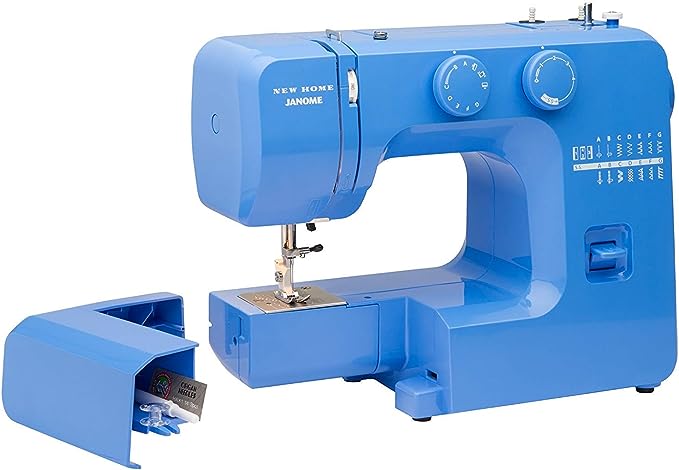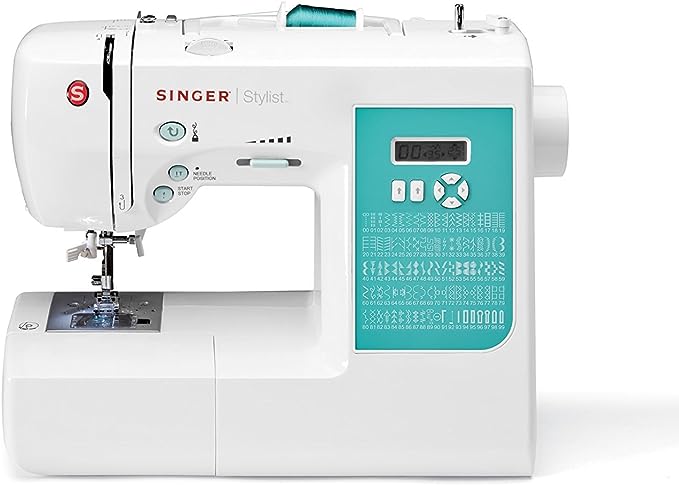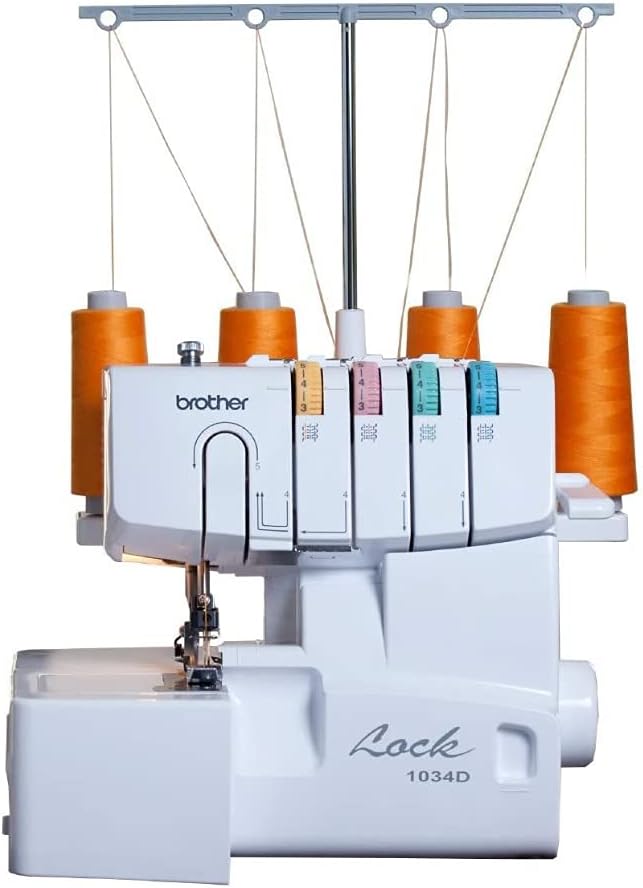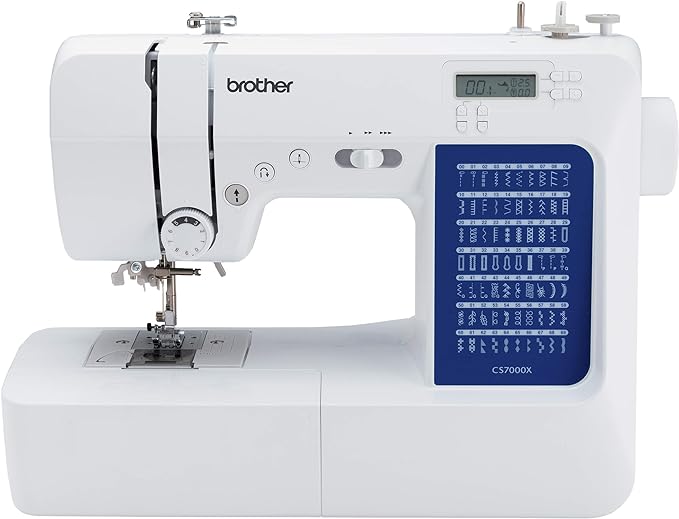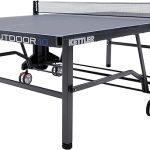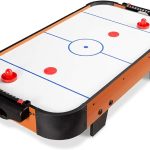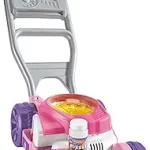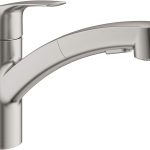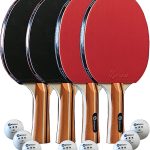As you sit at your kitchen table, surrounded by scraps of fabric and threads of inspiration, you envision creating something beautiful, something that brings a smile to someone’s face. But, where do you start? With so many sewing machines on the market, it’s intimidating to choose the right one, especially as a beginner. Fear not! We’re here to support you. From user-friendly interfaces to automatic needle threaders, we’ll explore the top machines that’ll have you stitching like a pro in no time. But, which ones made the cut?
Contents
- Janome Blue Couture Sewing Machine
- Brother Sewing and Quilting Machine
- SINGER Sewing & Quilting Machine
- Brother Serger 1034D Heavy-Duty Overlock Machine
- Brother Sewing Machine XM2701
- Brother CS7000X Computerized Sewing and Quilting Machine
- Factors to Consider When Choosing Beginner Sewing Machines
- Frequently Asked Questions
- Conclusion
Janome Blue Couture Sewing Machine
If you’re a beginner looking for a sewing machine that’s both easy to use and feature-rich, the Janome Blue Couture Sewing Machine is an excellent choice, thanks to its interior metal frame, tutorial videos, and design made specifically with beginners in mind.
You’ll appreciate the machine’s 15 built-in stitches, adjustable stitch length and zigzag width, and front-loading bobbin system, which make it easy to navigate and customize your sewing projects.
Additionally, the included accessories, such as the zigzag foot and blind hem foot, will help you tackle a variety of sewing tasks with confidence.
With its sturdy construction and reliable performance, the Janome Blue Couture Sewing Machine is perfect for garment construction, quilting, and other sewing projects.
Best For: Beginners and experienced sewists looking for a feature-rich and easy-to-use sewing machine.
Pros:
- Easy to use and navigate, making it perfect for beginners
- Feature-rich with 15 built-in stitches, adjustable stitch length and zigzag width, and front-loading bobbin system
- Sturdy construction with diecast metal internal components, ensuring reliable performance and durability
Cons:
- No specific cons mentioned in the product description
- No specific cons mentioned in the product description
- No specific cons mentioned in the product description
Brother Sewing and Quilting Machine
The Brother XR9550 computerized sewing and quilting machine is an excellent choice for beginners who want to tackle a wide range of sewing projects with ease.
With its 165 built-in stitches and automatic needle threader, this machine makes sewing easy and convenient.
You’ll appreciate the LCD screen that makes stitch selection a breeze, and the wide table that provides ample space for larger projects.
The machine comes with 8 included presser feet and a protective hard case, making it easy to get started right away.
Plus, the 25-year limited warranty and free phone and technical support for the life of the machine give you peace of mind.
With its durability, flexibility, and ease of use, this machine is perfect for sewing enthusiasts looking to improve their creative capabilities.
Best For: Sewing enthusiasts, beginners, and experienced seamstresses who want to tackle a wide range of sewing projects with ease.
Pros:
- Easy to use with various speed settings and multiple sewing patterns
- Lightweight and sturdy with a wide table and 8 included presser feet
- 25-year limited warranty with free phone and technical support for the life of the machine
Cons:
- Some users had issues with the pressure foot tension and horizontal thread placement
- No specific features mentioned for advanced quilters or specialized sewing tasks
- No carrying case or storage bag included with the machine
SINGER Sewing & Quilting Machine
For beginners seeking a versatile and thorough sewing experience, the SINGER Stylist 7258 100-Stitch Computerized Sewing Machine stands out as a top choice, offering an impressive 100 built-in stitches and a range of innovative features that cater to various sewing needs.
You’ll appreciate the heavy-duty metal frame’s durability and the large LCD screen’s clear display of selected stitches, stitch length, and width.
With adjustable stitch length and width, you can customize your projects to perfection.
The machine comes with an array of accessories, including 10 presser feet and a range of tools, ensuring you have everything you need to get started.
Best For: Beginners and sewing enthusiasts seeking a versatile and feature-rich sewing machine for various sewing needs, including fashion sewing, home decor, quilting, crafting, and heirloom sewing.
Pros:
- Offers 100 built-in stitches and adjustable stitch length and width for customization
- Comes with a range of accessories, including 10 presser feet and tools, to get started
- Features a heavy-duty metal frame and large LCD screen for durability and easy viewing
Cons:
- Some users report issues with the automatic stop spool peg, recommending manual stopping to prevent wear and tear
- May require some learning curve to master the various features and stitches
- No mention of customer support or repair services beyond the 25-Year Limited Power Supply warranty
Brother Serger 1034D Heavy-Duty Overlock Machine
The Brother Serger 1034D Heavy-Duty Overlock Machine is versatile, making it an excellent choice for beginners who want to tackle a variety of sewing projects with ease.
With its 3/4 lay-in thread system and lower looper threader, you’ll be able to switch between different stitches seamlessly.
The machine offers several stitch options, including:
• 4-thread overlock
• 3-thread overlock
• narrow hem
• rolled hem
• ribbon lock stitches
Additionally, the F.A.S.T. lower looper threading system and snap-on presser feet make it easy to change threads and switch between stitches.
With a speed of 1,300 stitches per minute, you’ll be able to complete your projects quickly and efficiently.
Best For: Beginner sewers who want to tackle a variety of sewing projects with ease.
Pros:
- Offers several stitch options, including 4-thread overlock, 3-thread overlock, narrow hem, rolled hem, and ribbon lock stitches.
- Has a F.A.S.T. lower looper threading system and snap-on presser feet for easy thread changes and stitch switching.
- Has a high speed of 1,300 stitches per minute, allowing for quick and efficient project completion.
Cons:
- Warranty is voided outside the US.
- No specific mention of automatic tension or sewing assist features.
- No carrying case or storage bag is included with the machine.
Brother Sewing Machine XM2701
The Brother Sewing Machine XM2701 stands out as an excellent choice for beginners, thanks to its automatic one-step buttonholer, which effortlessly creates virtually perfect buttonholes.
You’ll appreciate the 27 built-in stitches, including blind hem, decorative, and quilting stitches, which cater to various sewing needs.
Additionally, the six quick-change sewing feet, including buttonhole, zipper, and zigzag feet, will make your sewing experience more efficient.
With the built-in easy needle threader and jam-resistant Quick-Set top drop-in bobbin, you’ll spend less time on setup and more time on sewing.
The lightweight design and free arm make it easy to sew cuffs, sleeves, and pant legs.
Best For: Beginners and experienced sewers who want a versatile and easy-to-use sewing machine with a wide range of stitch options and features.
Pros:
- Automatic one-step buttonholer for perfect buttonholes and 27 built-in stitches for various sewing needs
- Lightweight design and free arm for easy sewing of cuffs, sleeves, and pant legs
- Built-in easy needle threader and jam-resistant Quick-Set top drop-in bobbin for efficient setup and sewing
Cons:
- No specific cons mentioned in the product description or customer reviews
- No specific cons mentioned in the product description or customer reviews
- No specific cons mentioned in the product description or customer reviews
Brother CS7000X Computerized Sewing and Quilting Machine
The Brother CS7000X Computerized Sewing and Quilting Machine is an ideal choice for beginners who want to get started with sewing and quilting with ease.
With its impressive 70 built-in stitches and automatic needle threader, operating this machine is a breeze.
You’ll appreciate the 7 one-step auto-size buttonholes and LCD display that make operating this machine easy.
The wide table and quilt guide provide ample space for larger projects, and the 10 included feet give you versatility for various sewing tasks.
You’ll also appreciate the metal frame and fixed needle bar that provide durability and stability.
Weighing just 14 pounds, this machine is portable and easy to store.
With a 4.7-star rating from over 2,700 customers, you can trust that this machine will meet your sewing and quilting needs.
Best For: Beginners and experienced sewers alike who want a versatile and easy-to-use sewing and quilting machine.
Pros:
- The machine’s computerized features, automatic needle threader, and large needle-to-arm workspace make it easy to use and versatile for various sewing tasks.
- The wide table and quilt guide provide ample space for larger projects, and the 10 included feet give you versatility for various sewing tasks.
- The machine is portable and easy to store, weighing just 14 pounds.
Cons:
- Some users mention minor quirks, such as the machine’s hesitation when backstitching.
- The machine may have limited power for thick materials.
- Some users may find the machine’s computerized features overwhelming at first.
Factors to Consider When Choosing Beginner Sewing Machines
When you’re in the market for a beginner sewing machine, you’ll want to ponder several key factors to guarantee you find the right one for your needs.
You’ll need to think about the type of machine that’s best for you, how portable you need it to be, and what your budget is.
Machine Type Options
When choosing a beginner sewing machine, you’re faced with a multitude of machine type options, each catering to different needs and sewing styles. As a beginner, you should weigh the pros and cons of which type of machine aligns with your sewing goals and preferences.
If you’re looking for a simple, easy-to-use machine with a limited number of stitch options, a mechanical sewing machine might be the way to go. They’re often affordable and suitable for beginners who want to focus on basic sewing tasks.
On the other hand, if you’re interested in exploring various sewing techniques, a computerized sewing machine might be the better choice. These machines offer more stitch options and advanced features like automatic needle threaders and LCD displays.
If you’re interested in garment construction or quilting, an overlock machine (also known as a serger) could be the perfect fit. And if quilting is your primary focus, a quilting machine with advanced stitching capabilities and features like automatic thread cutters might be the way to go.
Alternatively, hybrid machines offer a versatile sewing experience, accommodating various sewing tasks and projects.
Weight and Portability
Considering the type of machine that fits your sewing style is just the first step – now it’s time to think about how you’ll live with your machine, and that means thinking about its weight and portability.
A machine’s weight can range from 10-25 pounds, with lighter machines being ideal for frequent transportation and heavier ones often featuring more robust construction.
If you plan to take your machine to classes or store it in small spaces, look for built-in handles or carrying cases that make it easier to transport.
The Brother CS7000X, for example, is a compact machine weighing around 14 pounds, making it perfect for small sewing spaces and frequent transportation.
Ultimately, the ideal weight and portability of a sewing machine depend on your individual needs and preferences.
Do you prioritize ease of transport or durability and stability?
Price and Budget
As you start shopping for a beginner sewing machine, your budget will play a significant role in determining which features and capabilities you can afford.
Beginner sewing machines can range in price from under $100 to over $1,000, so you must determine how much you’re willing to spend before making a purchase.
If you’re a complete beginner, a machine in the $200-$500 range may offer the best balance of features and affordability. Be wary of extremely low-priced machines, as they may lack essential features or have poor build quality.
When setting a budget, consider the cost of accessories, such as threads, needles, and fabric, in addition to the machine’s purchase price.
You should also think about the long-term costs of ownership, including maintenance, repairs, and replacement parts, when evaluating the overall value of a machine.
Stitch Variety and Quality
With your budget in mind, it’s time to think about the types of stitches you’ll need to bring your sewing projects to life.
As a beginner, having a variety of built-in stitches can provide you with flexibility and creativity in your projects. Look for machines with a range of stitch options, including utility, decorative, heirloom, and quilting stitches.
The quality of stitches is also essential, so consider machines with features like automatic tension and adjustable stitch length and width. These features will help you achieve professional-looking results.
Some machines offer a high number of built-in stitches, up to 100 or 165, giving you more options to experiment with different stitches and techniques.
Additionally, some machines offer specialized stitches, such as blind hem, buttonhole, and ribbon lock stitches, which can be useful for specific sewing tasks and projects.
When choosing a machine, consider the threading system as well, as features like automatic needle threaders and jam-resistant Quick-Set top drop-in bobbins can make a big difference in the quality of your stitches.
Ease of Threading and Use
A sewing machine’s ease of threading and use is essential to a beginner’s sewing experience, and several features can make all the difference.
When choosing a machine, look for one with an automatic needle threader, which eliminates the need for manual threading and reduces eye strain. A built-in bobbin diagram and tutorial videos can also help you learn how to thread the machine correctly.
A front-loading bobbin system is generally easier to use than a top-loading system, as it allows for more visibility and control during the threading process.
Additionally, consider a machine with a reverse lever and adjustable stitch length and width, which provides more control over the sewing process and helps you achieve professional-looking results.
A free arm or removable free arm is also a valuable feature, as it provides more flexibility and ease of use when sewing cuffs, sleeves, and other hard-to-reach areas.
Automatic Features and Settings
When you’re looking for a beginner sewing machine, automatic features and settings can be a game-changer, streamlining your sewing process and producing professional-looking results.
These features can save you time, reduce frustration, and help you achieve consistent results.
For instance, an automatic needle threader can spare you the hassle of manually threading your needle, reducing eye strain in the process.
Automatic tension systems guarantee that your stitches are even and consistent, eliminating the need for manual adjustments.
Some machines even offer automatic stitch selection, allowing you to choose from a variety of pre-programmed stitches with the touch of a button.
Other convenient features may include automatic backstitching and thread cutting, as well as adjustable stitch length and width for customized stitches.
Some machines may also come with built-in tutorials or guides, providing step-by-step instructions for various sewing techniques and projects.
Sewing Surface and Arm Space
Your sewing machine’s arm space and surface area play a critical role in determining how easily you can manage fabric, particularly when working on larger projects like quilts or garments.
A wider sewing surface, typically ranging from 5-12 inches, provides more room to maneuver fabric, making it ideal for quilting and sewing large projects.
When choosing a sewing machine, consider the type of projects you plan to work on and the amount of arm space and sewing surface area required to accommodate your fabric.
If you’re planning to work on garments that require more flexibility, such as sewing cuffs, sleeves, and pant legs, a free arm sewing machine with a detachable arm is suitable.
Additionally, consider a machine with a removable extension table or quilting extension, which provides additional sewing surface area, making it easier to manage large projects and reducing fabric drag.
Warranty and Support Options
Before investing in a beginner sewing machine, consider the warranty and support options that come with your purchase, as they can profoundly impact your overall sewing experience. You’ll want to know that you’re covered in case anything goes wrong.
Some machines offer impressive warranties, like the SINGER Stylist 7258, which has a 25-year limited warranty. The Brother XR9550 also offers a 25-year limited warranty, plus free phone and technical support for the life of the product.
The Brother 1034D serger has a more limited 5-year parts and 90-day labor warranty, but it’s still a decent option.
Other machines require you to request warranty information, like the Brother CS7000X and the Janome Blue Couture. While this might seem inconvenient, it’s better than having no warranty at all.
Be sure to factor in the warranty and support options when choosing your beginner sewing machine. You never know when you’ll need help or repairs, and having a good warranty can give you peace of mind and protect your investment.
Frequently Asked Questions
Do I Need to Oil My Sewing Machine Regularly?
You’ll want to check your sewing machine’s manual, but generally, you should oil it every 1-3 months, depending on usage. If you notice squeaks or stiffness, it’s likely time for a quick oil change to keep it running smoothly.
Can I Use a Sewing Machine on a Surge Protector?
You’re wondering if it’s safe to plug your sewing machine into a surge protector. The short answer is yes, you can use a sewing machine on a surge protector, but make sure it’s a high-quality one with sufficient joule rating.
How Often Should I Replace My Sewing Machine Needle?
“When in Rome, do as the Romans do” – in this case, replace your sewing machine needle every 1-3 months or when you notice it’s getting dull, as a dull needle can cause poor stitching and even damage your machine.
Can I Sew Denim or Leather With a Beginner’s Machine?
You can sew denim with a beginner’s machine, but it’s challenging; leather is usually too thick. You’ll need a heavier-duty machine or specialized needles for leather, but denim might work with a denim needle and slow, steady stitching.
Do I Need to Buy a Sewing Machine With a Lot of Stitches?
“As you step into the world of sewing, imagine a palette of stitches at your fingertips, waiting to bring your creations to life. You don’t necessarily need a machine with a plethora of stitches, but having a few essential ones will give you versatility and freedom in your projects.”
Conclusion
You’ve made it! Now that you’ve explored the top 6 beginner sewing machines, you’re one step closer to tapping your creativity.
Did you know that 75% of sewing enthusiasts started sewing as a hobby? It’s never too late to join the club!
With the right machine, you’ll be stitching like a pro in no time.
Happy sewing!
